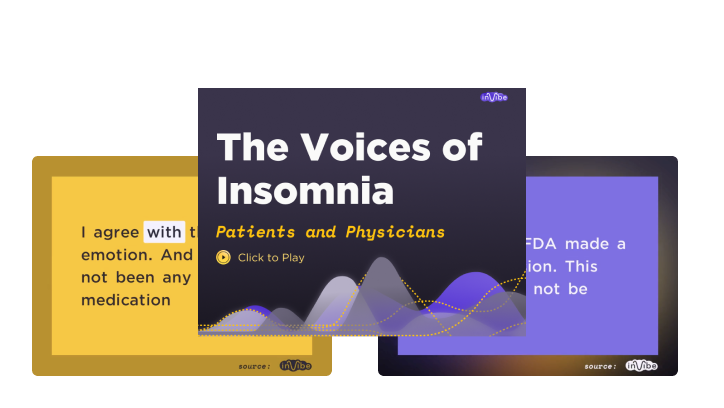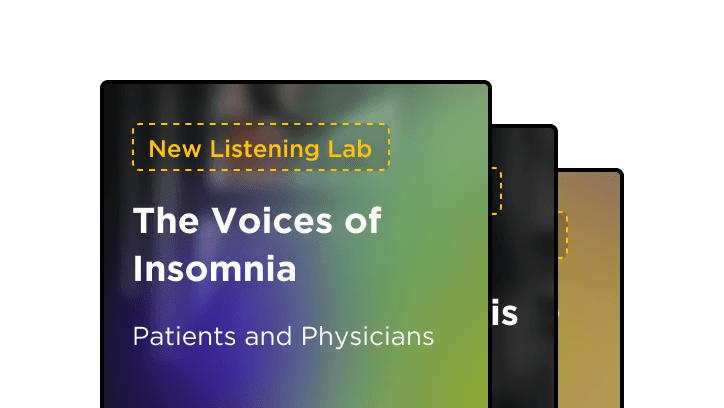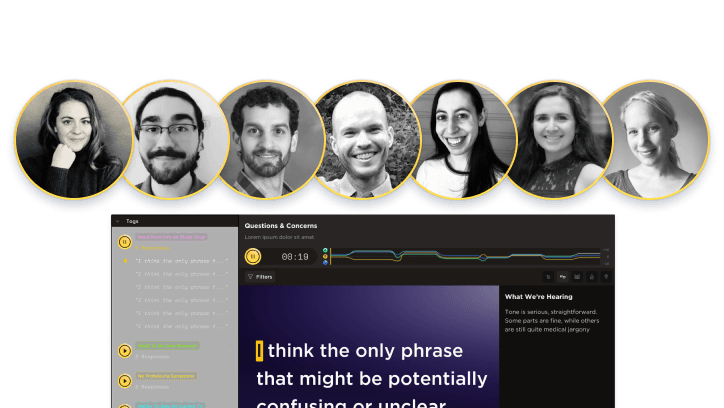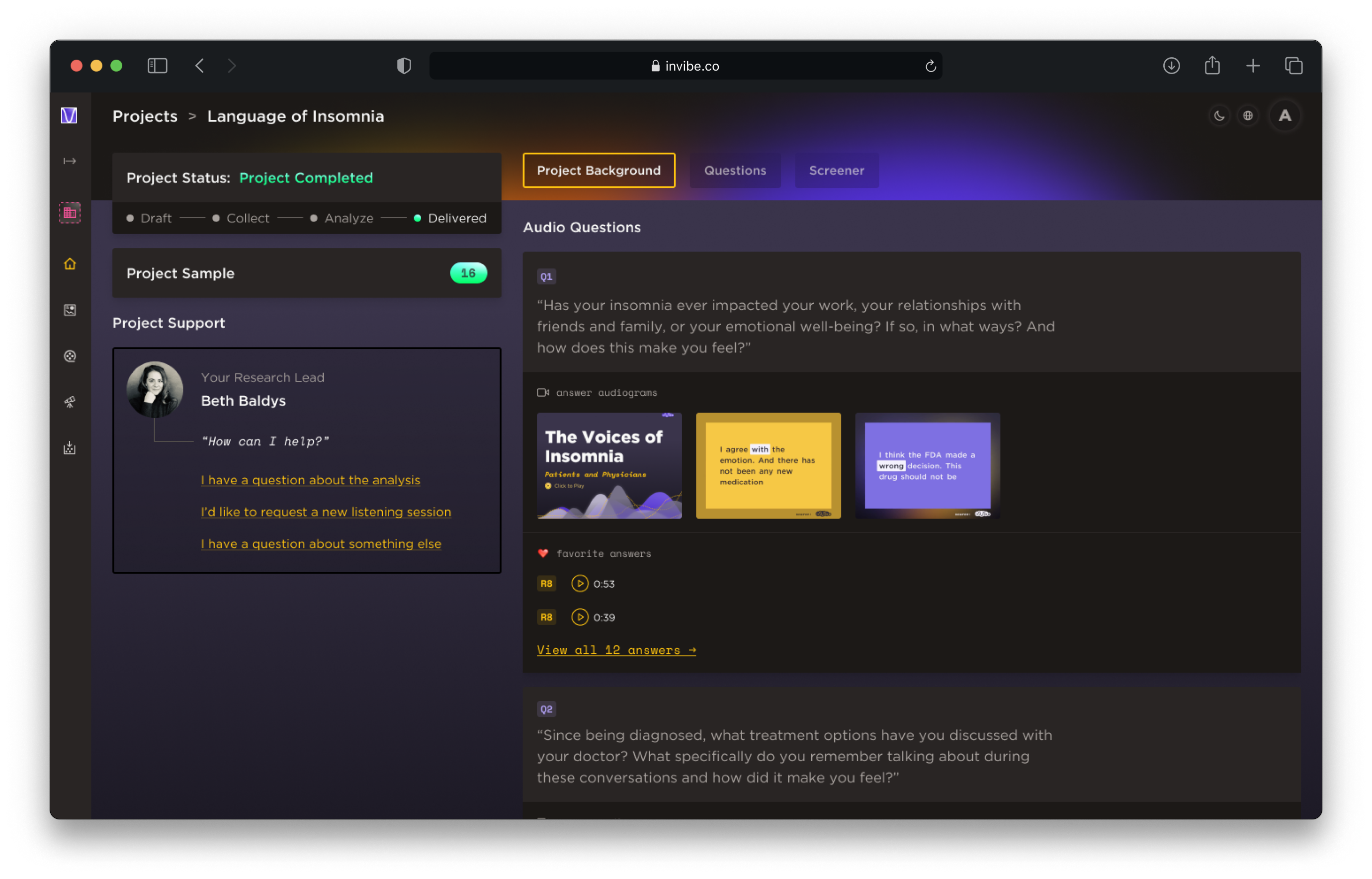Use Case
Language of Disease
Case Study
Understanding the Patient and Physician Language to Better Support and Communicate
Client Goal
18 months prior to the anticipated approval of a new insomnia treatment, our client sought to understand the language of symptom experience, diagnosis process, and treatment dynamics to better support and communicate with patients and physicians.
Objective 1
Understand how patients and physicians each talk about insomnia and its characteristics.
Objective 2
Explore the type of language and framing that resonates best with both patients and physicians.
Objective 3
Determine any communication gaps/traps that may lead to confusion or miscommunication.
The inVibe Solution
inVibe’s Language of Disease solution allowed our pharmaceutical client to quickly and efficiently deploy a voice-powered research study to obtain a robust understanding of the language both patients and physicians use, to ensure connectivity in their communications
1. Collect
Within 72 hours, inVibe screened and recruited 60 participants: 30 patients diagnosed with insomnia (various backgrounds and stages), and; 30 physicians who treat insomnia. All participants participated in an automated phone interview on their computers or smart phones, responding to questions by speaking.
Key Questions
/
Patient
Q1
Has your insomnia ever impacted your work, your relationships with friends and family, or your emotional well-being? If so, in what ways? And how does this make you feel?
Q2
Since being diagnosed, what treatment options have you discussed with your doctor? What specifically do you remember talking about during these conversations and how did it make you feel?
Q3
How do you think your life would be different if you didn’t experience insomnia? What would a snapshot of that life look like if you were to describe it to your doctor or a family friend?
Key Questions
/
Physicians
Q1
Imagine you are evaluating an undiagnosed patient complaining of insomnia symptoms. What questions are typically part of your evaluation? How do you determine a diagnosis of insomnia vs. other sleep-related disorders?
Q2
How do you typically deliver a diagnosis of insomnia to a patient? What specific words do you use (or try to avoid using) during these conversations?
Q3
Specifically, what are your goals and expectations for insomnia treatment? What are you hoping to hear from your patients in order to feel confident that their medication is ‘working’?
2. Analyze
inVibe’s analysts leveraged their language expertise and advanced NLP tools to process, evaluate and analyze multiple aspects of each response, including content, language, and emotion derived from speech-emotion recognition, allowing for deeper insights, faster.
What is Said
Summarize and categorize the content and themes.
How it’s Said
Identify the language patterns and construction.
How it Sounds
Utilize machine learning and acoustic technology to assess the emotionality.
3. Deliver
The client was provided with an interactive report via an online dashboard, along with the voice data, transcripts, and a high-level analysis. An in-house analyst walked the client through the most meaningful data, supporting each insight with specific voice data.
Audiogram
Videos
Clients have access to drag & drop tools to instantaneously create kinetic text animations from transcripts for internal sharing.

Listening
Labs
inVibe delivers self-guided interactive stories assembled from transcripts, audio, and charts – annotated with high-level expert observations.

Expert
Perspective
inVibe’s team of in-house analysts and language experts walk clients through the insights and recommendations derived from the research.


Key Insights & Recommendations
Based on the insights, inVibe recommended that the team take strategic actions:
#1
Bridge the gap between HCPs and patients by focusing on increased quality of life “the next day”, not just “the night of.”
#2
Mirror patients’ language to show the impact [the treatment] could have on their emotions, personal agency, and sense of self.
#3
Drive empathy by developing creative that translates “I just can’t sleep” into the reality of insomnia’s impacts.
Where are they now?
Our client used the research to pressure test the real language patients and physicians use to describe sleep disorders and ensure connectivity to their communications.
Today our client is focusing on the benefits not just of a good night’s slep, but waking up feeling rested - a distinction that resonated clearly with patients and physicians alike.
Ready to learn more?
/voice
/resources
/use-cases
- New Data Intelligence
- TrialPulse — Evaluation of Clinical Trial Recruitment Assets
- Concept / Message Testing
- Customer Journey Inflection Points
- Agency Pitch for New Business
- TrialPulse — DCT Design and Informed Consent
- Language of Disease
- Customer Stories
- Decision Drivers
- Market Trends
- TrialPulse — Disease Burden and Endpoint Selection
- HCP – Patient Communication
2025 inVibe - All Rights Reserved
